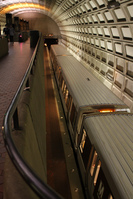Why the Blue Line needs to keep calling at Rosslyn
When discussing capacity constraints at Rosslyn, some suggest truncating the Blue Line at to make room for more Orange Line trains at Rosslyn. However, that is not the right approach.
For many commuters, the Blue Line is the quickest and most direct route to get to work. From Alexandria and points south and from southeastern Arlington, trains take riders directly to the job centers around Farragut Square and Metro Center.
As I pointed out, the Yellow Line bridge does not offer a quicker trip for those bound for the western side of downtown. Eliminating the entire Blue Line route through Rosslyn would severely inconvenience riders, and could affect ridership.
And at any rate, the Blue Line has ridership which, at present, is commensurate with the service levels at Rosslyn. Approximately 38% of trains at Rosslyn are Blue, and are carrying approximately 35% of the riders continuing through Rosslyn.
So the demand is certainly there for Blue trains via Rosslyn. At some point, as I discussed previously, it may become necessary to redirect some Blue trains via the Yellow Line bridge to make way for the Silver Line. Metro will probably make that decision based on the ridership patterns once the Silver Line opens and starts to build a rider base.
But it is still necessary to keep some Blue Line trains serving Rosslyn, mainly to meet the demand of riders headed to the western portion of Downtown and out the Orange or Silver Line corridors.
And if the service continues to Rosslyn, it must continue on to downtown DC. There are two primary reasons.
First and foremost, Rosslyn is incapable of serving as a terminal. It has two platforms and two tracks. There is no crossover at the station. In fact, any train that went out of service at Rosslyn would have to continue to Foggy Bottom and then enter the crossover just east of that station before turning around. And of course, as was pointed out with regard to the Yellow Line, headways are such that a pocket would be necessary anyway.
The other reason that any train serving Rosslyn must continue toward downtown DC is that it is already taking up one of the “slots” on the Orange/Blue subway. The switch at Rosslyn is capable of handling 26 trains per hour in each direction. If, say, 4 of those slots were given to Blue Line trains going out of service at Rosslyn, that would mean 4 fewer trains making it Downtown, period.
So barring a complete redesign of the station at Rosslyn, anything that makes it that far has to continue on to downtown DC. The first feasible place to turn back a train on the Blue/Orange subway is the pocket just east of Stadium-Armory.
With that in mind, some of you may be wondering whether the Blue Line even needs to go to Rosslyn. It does. Aside from the fact that the ridership shows that there is demand, there is more to Blue Line service through Rosslyn.
It is currently possible to travel from any one of Metro’s 86 stations to any of the other 85 by taking no more than 2 trains. That’s because every single line intersects every other line. In some cases, this happens twice. That adds redundancy to the system and makes Metro more convenient.
Cutting the Blue Line back to Arlington Cemetery would hurt not only Blue Line riders, but those in the core, too. This is because riders coming from Alexandria and south headed for Rosslyn, Ballston, or Tysons and vice versa are able to make that trip without entering the core. While giving all 26 slots at Rosslyn to the Orange and Silver Lines might seem to reduce crowding, the fact is that riders who currently change from the Orange at Rosslyn to the Blue would have to stay on trains all the way to L’Enfant - exacerbating problems in what is already the most crowded part of the system.
Crowding on the Metro is not going to ease any time soon. There are some steps that can be taken to reduce the current impact and stave off the time when the system runs out of capacity. These strategies include increasing the number of 8-car trains and better balancing of the multiplexed lines. But the only long-term solution will be to build a separated Blue Line, including exclusive platforms at Rosslyn.

